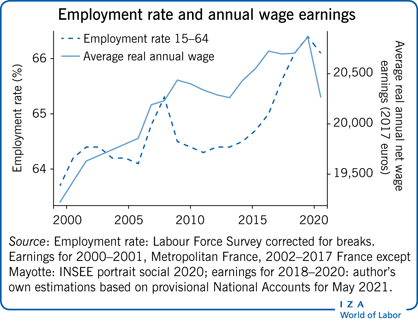Elevator pitch
France has the second largest population of countries in the EU. Since 2000, the French labor market has undergone substantial changes resulting from striking trends, some of which were catalyzed by the Great Recession and the Covid-19 crisis. The most interesting of these changes have been the massive improvement in the education of the labor force (especially of women), the resilience of employment during recessions, and the dramatic emergence of very-short-term employment contracts (less than a week) and low-income independent contractors, which together have fueled earnings inequality.

Key findings
Pros
Massive furlough schemes have avoided employment ravages among permanent workers during the lockdowns and sanitary restrictions in 2020–2021.
The proportion of tertiary-educated workers is continuously increasing, while their employment rate remains high and acyclic.
The Great Recession did not stop the rise of the employment rate for women; it is now stabilized at its highest level since World War II.
The labor force participation of workers aged 50–64 has risen significantly.
Real earnings of the average and median full-time worker have risen until 2019.
Cons
Long-term unemployment and older workers’ unemployment never fully recovered from the Great Recession.
Spatial heterogeneity in unemployment is still large.
The use of very-short-term labor contracts (less than a week) has increased dramatically.
Annual earnings inequality has increased, driven by a decline in real terms at the bottom of the distribution.
New independent contractors replacing traditional artisans or involved in gig activities have low incomes and poor social protection.